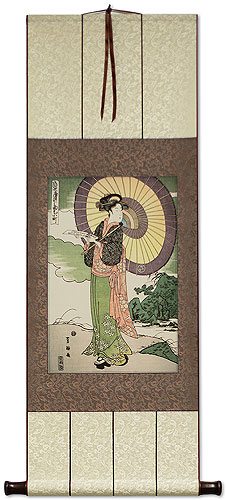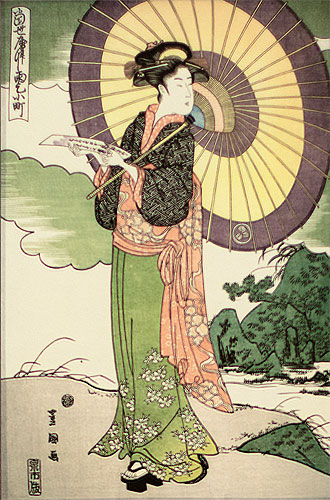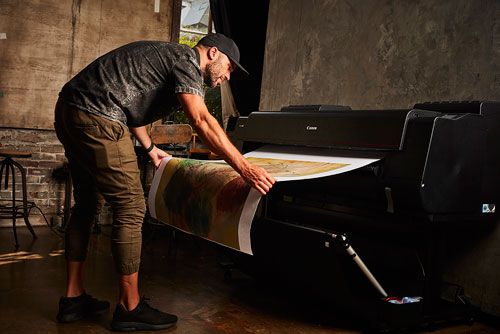
41¼"
18¼"

Approximate Measurements
Artwork Panel: 28.3cm x 42.6cm ≈ 11" x 16¾"
Silk/Brocade: 37.5cm x 104.7cm ≈ 14¾" x 41¼"
Width at Wooden Knobs: 46.5cm ≈ 18¼"

Close up view of the artwork mounted to this silk brocade wall scroll
This depicts a beauty with an umbrella out for a stroll. She pauses to look back over her shoulder as she holds a poem slip in her hands, the umbrella handle resting against her shoulder. Her green kimono is bordered with blossoms and tied with a darker green obi with a rosy floral pattern. Clouds drift across the sky and hills can be seen on the opposite shore of the water behind her.
Original artist: Utagawa Toyokuni I / 歌川豊国初代 (1769–1825).
Original woodblock was created in Japan in the early 1800s. I bought a more recent (early 1900s) print that has excellent color - over 100 years old but well preserved with no fading. I imaged that with my new Canon EOS 5D in my photo studio, removed some blemishes digitally, and made a great image for you.
Some of the characters on this print include:
豊國画 (Toyokuni's painting).
A stamp: [极] (kyoku) - climax or highest point.
A stamp: [泉市版] (Izumi-shi edition) indicating that 和泉屋市兵衛 (Izumiya Ichibei) is the printmaker of this addition.
The title in the upper left looks like 当世磨?雨乞小町. It seems that the third and/or fourth characters are old and no longer used in Japanese (I could not read the 4th one), so the accepted title (which you will find that Japanese auction houses use) is "当世やつし雨乞小町" meaning "[In the] Present Time, Komachi Makes/Prays-For Rain". Komachi can be a Japanese surname, but the meaning is "a beauty", so in this context, it almost certainly refers to the woman in this artwork.
Woodblock printing, often considered the precursor to the modern printing press, was first developed in China and later brought to Japan, where artists refined the technique into a unique art form. In Japan, these prints are called 木版畫 ("Moku Hanga"). Most were created during the Edo period (1603–1867), though production continued into the early 20th century.
Japanese artists would first create a "template painting" depicting scenes of daily life, including women washing clothes, men writing poetry, samurai battles, and occasionally more dramatic subjects. These template images, known as 浮世絵 (Ukiyo-e, or "Floating World"), were then carved into wood by skilled artisans. Another specialist applied wet ink or pigments to the carved blocks, and a sheet of handmade paper was pressed on to create the final print. This collaborative process produced vibrant, detailed artworks much faster than hand-painting hundreds of copies.
Original Japanese woodblock prints from the Edo period can sell for $800 to $20,000. Our prints are high-quality reproductions, crafted to capture the look and feel of the originals, though experts will recognize them as reproductions.
We use authentic handmade kozo (mulberry) paper—the same paper Japanese printmakers used centuries ago. Archival, UV-resistant pigment inks ensure long-lasting color, with laboratory testing showing up to 95 years of fade-free enjoyment if kept out of direct sunlight. Each reproduction is carefully color-corrected and restored, bringing the Edo period artwork to life for your wall.

Photographer Jeremy Cowart and the Canon imagePROGRAF PRO-2000 giclée printer used to create these reproductions.
Printing on delicate handmade paper is challenging. After testing multiple high-end printers, we found the Canon imagePROGRAF PRO-2000 delivers the precision and quality needed, using 12 archival inks and 18,432 nozzles. Each print is then sent to our Beijing workshop, where it is mounted into a handmade wall scroll, ready-to-hang without the need for expensive framing, giving your piece an authentic Japanese look.
Because the original artist has long passed, these works are public domain. In some cases, we license high-resolution scans of original prints, or even scan 200-year-old originals ourselves. This dedication ensures you receive a stunning Japanese woodblock print reproduction at an affordable price, making traditional Asian art accessible to everyone.
Want a custom wall scroll or unique print size? Just contact us!
We can print larger sizes, choose your preferred paper texture, and select silk brocade colors. Ready-to-frame prints can ship in days, while custom wall scrolls may take several weeks. Either way, the result is a truly one-of-a-kind piece of Japanese art.